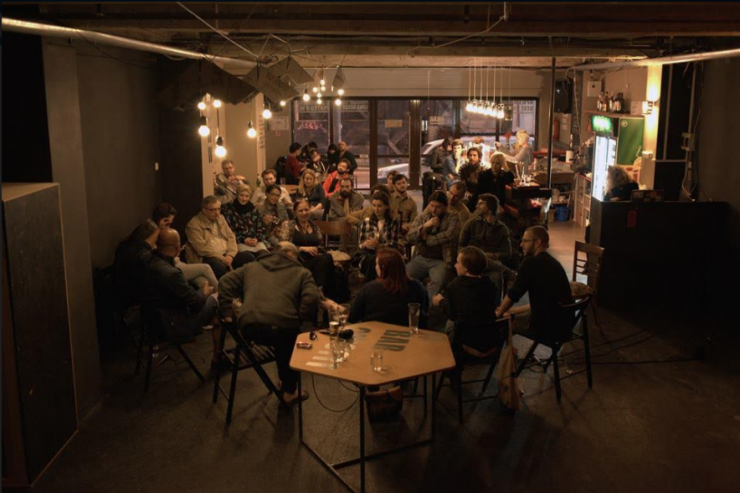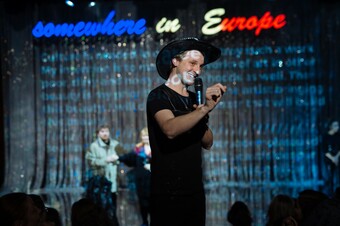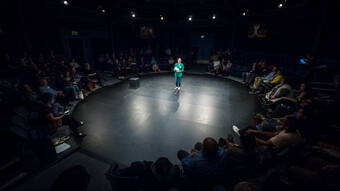How to Get Rid of Chairs
Dilemmas of the Independent Performing Arts Sector in Romania
IETM (International network for contemporary performing arts) gets ready to host its Plenary Meeting in Bucharest, Romania, with a particular focus on the current position of the artist in contemporary societies, as well as on the financial and social conditions of pursuing a career in the arts. This series of articles reveals what is to be an artist in today's Romania.—Elena Polivtseva
“I don’t want to work with only three chairs in my shows,” says Catinca Drăgănescu. Catinca is a stage director working almost exclusively on the independent scene in Romania, and her words were a sort of an answer to the question of why she was interested in directing in public theatres.
Note: There is a difference between independent and private theatre in Romania: private theatre is for-profit, and independent theatre is non-profit. “Profit” is a big word here in terms of theatre, as we don’t actually have what’s called commercial theatre. But there is a visible and sometimes stated difference between a form of theatre (and production) based on experiment, an original language, non-typical modes of production, equally non-typical artistic relationship within the team and which most of the times sees itself as a public service, and a theatre aimed at entertaining and gratifying an audience as large as possible, through a variety of catching artistic formulas. It’s not that one option is good and the other is bad: they are just different, and complement each other.
The “three chairs” Catinca mentions is a common phrase when talking about the aesthetics of independent productions in Romania. It’s not so much a metaphor as a form of “our means of production in a nutshell”: a lot of such independent shows have a maximum of four performers, and for a long time that was almost the norm. Until she started collaborating with public institutions, Gianina Cărbunariu (the best known and most acclaimed writer-director of the “new theatre”) worked only with three or four actors.
That might not seem uncommon for cultures where theatre is not subsidized by the State, but it is unusual when compared with the extremely large casts of Romanian state theatre productions. And, indeed, in a lot of situations, the sets in the independent shows consist of mainly, if not only, a bunch of chairs. Bogdan Georgescu has even turned the use of chairs into a concept throughout his shows: chairs have been given dramaturgical roles—they signal social status, social context, etc.—instead of the neutral, functional ones they inevitably have otherwise.
Again, even if such precarity sounds pretty much normal for other theatrical cultures (where big casts, lavish sets and costumes, large stages and a generous technical staff are the prerogatives only of certain rich productions with expensive tickets), it’s not the kind of theatre Romanian artists are trained for—on the contrary. When Catinca Drăgănescu decries the resources for a show reduced to a couple of chairs, she decries, on the one hand, the impossibility to put at work all the things she was taught to do in university, and on the other, the dramatic limitation of repertorial choices on the independent scene. Many a time, limitations do force an aesthetical reshuffle, and they did it for the Romanian stage: the studio performances fostering an intimate relation between the performers and the audience, Becket-style minimalism, the playwright-director, documentary-based and community-based theatre, all were developed here as “by-products” of precarity; of technical and artistic limitations. But there’s a point where precarity and lack of resources stops boosting creativity and falls back to what it really is: sustained poverty.
The US doesn’t legally recognize neighboring rights for non-fixed works, such as live performances, because what an actor does in rehearsals and on stage is considered to fall under the Labor Code. Well, in Romania only actors employed by state theatres work; the others...transfer their rights.
According to an ad-hoc survey (made by me in 2015) that had around fifty respondents, most of the actors and all the directors worked, at some point, in a self-financed performative project. Usually, self-financing doesn’t necessary mean investing money (even if sometimes directors advance sums from their future potential neighboring rights contracts), it means working/rehearsing for free (and without a contract), in their own homes, using their own clothes as costumes and home utensils as props. Again, it might not sound extraordinary for performing artists in, let’s say, Latin America, but it proves something is not quite right in a theatrical environment dominated—in terms of visibility and desirable modes of production—by public institutions with considerable resources. It’s like living in a shack with a perpetual view of the villas of the state-supported neighbors: frustrating. And it often generates the feeling—especially for actors—that their independent work is some casting-rehearsing for the “big,” “real” theatre.
In the last decade, the financing sources for independent productions have diversified, but no matter how much they’ve done so, there is no regulated framework for supporting technically equipped non-public theatres and no money for the everyday activity. The concept is called project-based system: things happen per project, for a short or medium amount of time, and in between projects, the continuity of artistic practice is ensured through improvisations, artistically non-related activities, and legal/financial contortions worthy of the Wild, Wild West. Not even the most successful (whatever that means in Romania) independent artists or producers can afford working contracts, with their corresponding social protection; everybody is working on author’s rights/neighboring rights contracts and hopes not to get sick or old. The US doesn’t legally recognize neighboring rights for non-fixed works, such as live performances, because what an actor does in rehearsals and on stage is considered to fall under the Labor Code. Well, in Romania only actors employed by state theatres work; the others...transfer their rights.

Some artists and producers open their own venues that are not bars and cafés—there is a multi-disciplinary (visual arts/theatre/dance) space in Cluj, in the premises of the former Paintbrush Factory. There is the Replika Centre for Educational Theatre in Bucharest. In Bucharest, there are also UNTEATRU, on the second floor of an old semi-industrial building in the city center, which hosts now from art galleries to various businesses, and Apollo111, the first Romanian Maecenas-supported stage (the Maecenas is a bank), and Macaz Bar Theatre Coop—a hub for political art, run as a cooperative, in Bucharest. As its name says, Macaz is also a bar—beverages sell better than theatre. All of these spaces are rented from a variety of owners, from the market or through personal connections, and the artistic activity sometimes helps gentrify the area and in some cases it ends up raising the value of the building (including the rent...). The founder of the Point Theatre, also in the city center of Bucharest, a private one, owns the building and directly finances all production costs. All he wants is not to lose (a lot of) money, and pay the actors from the show revenues. Point was forced to lower the initial ticket prices: there aren’t so many people in Bucharest who can afford and are willing to pay more than $15 a ticket, when the monthly average income in the city is $540.
The main reason why the system of independent theatre and the condition of independent artists are totally deregulated and appear to be left prey to some experimental neoliberal free market principals is, paradoxically, the exact thing that keeps the art of theatre still alive in Romania: the public theatre. Let’s go to the question that stage director Theodor-Cristian Popescu was addressing in his HowlRound article: can actors both permanently employed and freelance all have the same status? Maybe we can have something like that, if a compromise is reached. Can we have two different but equally fair systems, one for the permanently employed and the other for those working on the independent scene? No, we cannot. First, because the two systems are not running in parallel—actors, directors, and designers employed in public theatres do work in non-public productions, and vice-versa, some independent artists (actors, mainly) do at some point get a working contract in public institutions, while continuing to appear/direct, etc. on the independent/private scene. And nobody can get the better of two worlds at the same time. Welfare state is great but it’s not Santa Claus. Equally, when the State subsidizes, on average, more than 80 percent of the expenses of public theatres (out of which 65 percent are salaries), not to mention that they all own their venues, it’s highly improbable that the same state could ever afford a similar support for everybody who does theatre in this country. In fact, it cannot do it for anybody else, at similar levels, taking into consideration how expensive an art is the theatre. And this is the point where we all are: a fair(er) system, socially and artistically, which could ensure the survival of state-supported theatre providing a public service, would mean taking something from public theatres in order to give something to the now “outsiders.” Taking something means a rethinking of the whole mode of production in public theatres, in terms of economy of expenses, efficiency, sharing of resources. And that’s not something that most people running public theatres or benefiting from the current situation are willing to accept. This is the war we are in.
When discussing live performances in Romania, there is one recurrent issue: the (very) low participation rate, the lowest in the Europe Union. The latest survey made by the European Commission (for the year 2011) places Romania below Bulgaria, with 26 percent participation in live performances. The latest barometer of cultural consumption made by the Romanian authorities (for the year 2015) places the consumption of theatre events at 35 percent (and 11 percent for opera and philharmonics). But while the Romanian barometer measures consumption (i.e. participating as a member of the audience), the European survey counts both going to the theatre (opera, etc.) and taking part in non-professional theatre-related activities. Amateur live performances and theatre activities are basically non-existent in our country, which still associates non-professional arts “for adults” with the infamous “Song to Romania” National Festival invented by Nicolae Ceaușescu in 1976.
And it’s worth going deeper into this low participation rate, since it does relate to the predicaments of the independent theatre scene. Generally, cultural participation highly depends on how the (state-supported) cultural offer interconnects with the level of education and the ratio between rural and urban areas. Romania not only has 46 percent of its population living in the countryside (as per 2011, the latest census), more than most EU countries, but also the differences in living standards and average income between cities and villages are huge. The communist regime didn’t attempt to develop the village but to destroy it by forced urbanization and industrialization, which resulted in most of the rural population still living now in early 20th century conditions. And Romania has the smallest percentage of college/university-educated people in the EU: 15 percent.
But what kind of culture is the Romanian state supporting, through subsidies and regulation? High culture, of course. Public theatre in Romania means permanent companies with their own dedicated venues in the city and a repertory addressed to their traditional main audience—the educated urban class. With the touring system destroyed after the fall of communism, shows only travel for festivals or in small regional exchanges (Hungarian and German speaking theatres travel more), with the puppetry and youth theatres venturing more outside their own venues.
It’s not the idea that subsidy has to produce “worthy,” “big,” “important” things alone; it’s also the perspective of theatre managers and theatre artists working in public theatres: they are in a aesthetical competition with one another and with the national theatrical tradition, in the field of “value,” not in a quest for keeping, finding, enlarging or provoking their audience.
So who’s left with the mission of designing and implementing projects in cultural education, cultural intervention, audience development, or community art? Who’s expected to go in culturally deprived areas? Of course, the independent sector, which doesn’t have the strength to develop sustainable programs with results able to resist time, because it is impossible for it to institutionalize itself. And there is something else: even if the independent theatre is almost officially given the specific niche of whatever is not high art to fill (by “officially” I mean the public grant schemes, the only ones open to independents, always have priorities related to these fields of education, intervention, social and community art...), in order to be recognized and have access to resources, its artists still have first to “confirm,” to “prove” themselves according to the standards of the guardians of high culture and public theatre. Everybody craves professional recognition, and for preserving the current order, the system needs gatekeeping strategies. Back to square one. The audience is agonizing around us, together with the new generations of artists, but the principles are well guarded. To the death of everything.








Comments
The article is just the start of the conversation—we want to know what you think about this subject, too! HowlRound is a space for knowledge-sharing, and we welcome spirited, thoughtful, and on-topic dialogue. Find our full comments policy here
Well, nice start and terrifying ending for that matter. The independent theatre makers make a choice: to be the pioneers of something that is well established in other countries: freelancing. Is it tough? yes it is. But we make it tougher by dividing us: first of all, there are other indie theatres worth mentioning in this article, but well... Are we (indie theatres) heading to the death of everything? hell, no! Let's start a joint discussion with all theatre makers and lay all our needs and deeds on the table. Maybe it will happen, maybe it won't, but definitely every one will keep their aces up their sleeves not to be shared. The lack of union, that is one of the main issues. The state will never help us more if we will not ask for more.Now, regarding the audience... that is a topic, indeed! Let's face it - in Romania either you have audience recognition, either you have branch recognition...